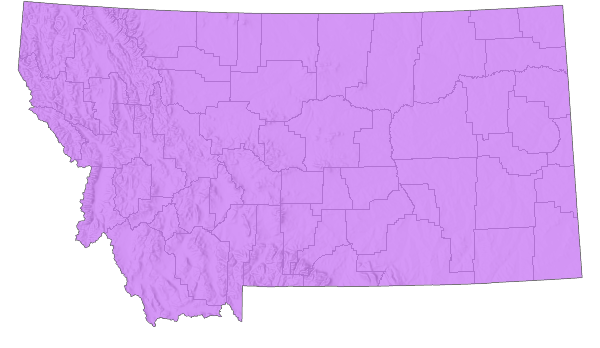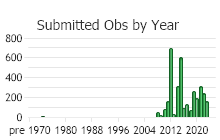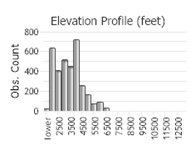View in other NatureServe Network Field Guides
NatureServe
Montana
Utah
Wyoming
Idaho
Wisconsin
British Columbia
South Carolina
Yukon
California
New York
Sago Pondweed - Potamogeton pectinatus
Other Names:
Stuckenia pectinata
Native Species
Global Rank:
G5
State Rank:
SNR
C-value:
5
Agency Status
USFWS:
USFS:
BLM:
External Links
General Description
PLANTS: An aquatic, rhizomatous, perennial with terete, branched stems;up to 75 cm long. Lowest portions of the stem branch more than the upper portions. Turions are absent. Sources: Lesica et al. 2012; Haynes and Hellquist in Flora of North America (FNA) 2000.
LEAVES: Submersed leaves attach to the stipule and not directly to the stem. Submersed leaves are very slender or threadlike (filiform), 1-10 cm, <1 mm wide, and tapering for more than 3mm at the tip (Lesica et al. 2012). The lower stipules of the leaves are 16-30 mm long and sheathing (Lesica et al. 2012). Floating leaves are absent. Source: Lesica et al. 2012.
INFLORESCENCE: Small, inconspicuous flowers are borne in distinct whorls on 1-5 cm long spikes. Source: Lesica et al. 2012.
The specific epithet pectinatus is from the Latin pectinate meaning narrow with divisions like a comb. This refers to the slender comb-tooth-like leaves (Merriam-Webster 2019). Potamogeton is derived from the Greek words potamos meaning river and geiton meaning neighbor (Merriam-Webster 2019).
Phenology
Sago Pondweed flowers from summer through fall (Haynes and Hellquist in FNA 2000).
Diagnostic Characteristics
Montana has 21
Potamogeton species. They are all aquatic perennials with submergent leaves, but some species also have floating leaves, often of a different shape. All species have small, sessile flowers arranged in a cylindrical spike with a long stem (peduncle) that grows from the axil of a leaf.
Many floras have split
Potamogeton into two genera based on molecular evidence and the following morphology (Haynes and Hellquist
FNA 2000; Giblin et al. [eds.] 2018):
Potamogeton
*Floating leaves present or absent.
*Submersed leaves: Stipule is free from the leaf blade, or if attached the fused (adnate) portion is 5 mm or less and no more than half the stipule’s length.
*Submersed leaf blades are translucent, not channeled, and are flat.
*Peduncle of the inflorescence is stiff and can project above the water.
*18 Montana species.
Stuckenia
*Floating leaves never present.
*Submersed leaves: At least two-thirds of the stipule is adnate to the base of the leaf, usually for more than 10 mm and it forms a sheath around the stem.
*Submersed leaf blades are opaque, channeled, and are turgid.
*Peduncle of the inflorescence is flexible and does not project above the water (is submersed).
*3 Montana species.
Sago Pondweed-Potamogeton pectinatus, native
*Stems: Cylindrical (terete)and branched. Highly branches, especially above.
*Floating Leaves: absent.
*Submersed Leaves: Filiform, 1-10 cm long and <1 mm wide, and attached directly to the stipule (not the stem). Leaf tip acute to acuminate, apiculate, or mucronate on young plants. Leaf tapers within the last 3 mm of the tip.
*Stipules: Lower stipules 1.5-30 mm long, tightly sheathing, but not swollen. Tip of stipule extends as a ligule up to 20 mm beyond their junction with the base of the leaf blade.
*Spikes: 1-5 cm long with distinct whorls of flowers.
*Tepals: Brownish-green and 1-1.5 mm long.
*Achenes: 3-4 mm long and obscurely keeled with a slender, curved beak.
*Rhizomes tuberous.
*Often confused with Potamogeton filiformis or Potamogeton vaginata.
Slender Pondweed-Potamogeton filiformis, native
*Stems: Cylindrical (terete) and branched. Less branched above.
*Floating Leaves: absent.
*Submersed Leaves: Filiform, 1-8 cm long and 1-2 mm wide, and attached directly to the stipule (not the stem). Leaf tip acute to acuminate or blunt or asymmetrically notched. Leaf tapers only within the last 1 mm of the tip.
*Stipules: Lower stipule 5-15 mm long and sheathing. Tip of stipule extends as a ligule up to 20 mm beyond their junction with the base of the leaf blade.
*Spikes: 1-5 cm long with distinct whorls of flowers.
*Tepals: Brownish and 1-2 mm long.
*Achenes: 2-3 mm long and obscurely keeled with a minute beak.
*Rhizomes not tuberous.
*Often confused with Potamogeton vaginatus or Potamogeton pectinatus.
Sheathed Pondweed-Potamogeton vaginatus, native
*Stems: Cylindrical (terete) and branched.
*Floating Leaves: absent.
*Submersed Leaves: linear, 2-10 cm long and 1-2 mm wide, and attached directly to the stipule (not the stem).
*Stipules: Lower stipule 1-5 mm long and sheathing, brown, and swollen at the base. Tip of stipule extend as a ligule, 0-2mm beyond their junction with the base of the leaf blade.
*Spikes: 1-5 cm long with well-separated whorls of flowers.
*Tepals: Brownish-green and 1-2 mm long.
*Achenes: 2-3(-3.8) mm long and obscurely keeled and beaked.
*Often confused with Potamogeton filiformis or Potamogeton pectinatus.
Blunt-leaved Pondweed-Potamogeton obtusifolius, native, SOC
*Stems: Slightly compressed and branched with globose glands at the nodes.
*Floating Leaves: absent.
*Submersed Leaves: Linear, 3-8 cm long and 2-4 mm wide, with a blunt tip, and attached directly to the stem at the base of the stipule.
*Stipules: 1-2 cm long, membranous, and sheathing.
*Spikes: About 1 cm long.
*Tepals: Green and about 1 mm long
*Achenes: Barely keeled and 3-3.5 mm long including the erect beak.
Curly-leaf Pondweed-Potamogeton crispus, exotic, noxious
*Stems: Slightly flattened and mostly straight.
*Floating Leaves: absent (though stems break off and float).
*Submersed Leaves: Mature leaf blades clasp the stem, are linear to oblong with wavy margins (like a lasagna noodle) and minute teeth. Leaves lack a stem (petiole).
Leafy Pondweed-Potamogeton foliosus, native
* Montana plants are variety foliosus.
*Stems: Slightly compressed and branched and lacking globose glands at the nodes.
*Floating Leaves: absent.
*Submersed Leaves: Linear, 1-4 cm long and about 1 mm wide, and attached directly to the stem at the base of the stipule.
*Stipules: 5-10 mm long and sheathing but frying above.
*Spikes: 1-6 mm long and capitate.
*Tepals: Green and =1 mm long.
*Achenes: 1.5-2 mm long. Abaxial keel is wing-like and beak is erect, 0.2-0.6 mm.
*A combination of linear leaves and fruits with an undulating, wing-like abaxial keel (not lateral keel) are most likely this species.Species Range
Montana Range
Range Descriptions

 Native
Native
Range Comments
Sago Pondweed is a circumboreal species and in North America it grows throughout the United States and south to Mexico (Lesica et al. 2012).
Observations in Montana Natural Heritage Program Database
Number of Observations: 3338
(Click on the following maps and charts to see full sized version)
Map Help and Descriptions
Relative Density

Recency



 (Observations spanning multiple months or years are excluded from time charts)
(Observations spanning multiple months or years are excluded from time charts)
Habitat
Sago Pondweed prefers shallow to deep, often saline or alkaline water of ponds, lakes, streams, and ditches in plains, valleys, and montane zones in Montana (Lesica et al. 2012). It is most often found in standing waters but may also flourish in running waters if they flow at low velocities (Pilon et al. 2002).
Range wide, it also thrives in brackish waters of estuaries and coastal ponds (Haynes and Hellquist in FNA 2000).
Ecology
HERBIVORY
Sago Pondweed is a main food source for many species of waterfowl throughout the year (Pilon et al. 2002). During the summer, coots (Fulica spp.) and ducks (Anas spp.) consume above-ground shoots and seeds. In the fall, migrating Tundra Swans (Cygnus columbianus) feed on the subterranean buds. Peak season standing crop may decrease from 17 to 40 percent and tuber biomass may be reduced by 48 percent due to this heavy herbivory.
The entire plant is palatable and may be consumed by diving, dabbling, whistling ducks, many types of geese, swans, coots, and long-billed dowitchers (USDA 2010).
LATITUDINAL VARIATION
A study done on variation of life-cycle characteristics of Potamogeton pectinatus over a broad latitudinal range revealed alteration of life-cycle strategies to cope with different climatic conditions (Pilon et al. 2002). When examining vegetative reproduction, clones produced at higher latitudes have higher proportional allocation of biomass to tubers and produced a greater number of tubers per individual. While these tubers were smaller than those at lower latitudes, total biomass of tubers was still greater. This may be explained by taking into account the shorter growing season and longer photoperiod each day. The shorter growing season encourages plants to produce tubers earlier in the season and then leaves less photosynthetic material to provide carbohydrates, resulting in smaller tubers. Clones at higher latitudes also exhibited a lower frequency of tuber development over time, a possible adaptation for juvenile plants avoid damage from unpredictable thermal conditions early in the growing season. Higher latitudes also show an increase in total number of leaves that an individual produces. However, total number of leaves was negatively correlated with leaf length and leaf biomass.
BIOCONTROL USES
Sago Pondweed has several restoration uses (USDA 2010). This includes use as a bioremediation agent to suppress phytoplankton blooms by taking up available phosphorus from the water. It is also suggested that Sago Pondweed could be a useful tool in monitoring heavy metals and pollution in water because of its frequent presence in organically polluted waters (Whitton et al. 1981). Erosion of shores and dams may be reduced using the wave inhibiting action of large populations of Sago Pondweed (Kantrud 1990).
ALLELOPATHIC POTENTIAL
Potamogeton species contain terpenoids and alkaloids, both potential allelochemicals (Gao et al. 2017). Allelochemicals are biochemicals released by plants that affect the growth, health, behavior, or population biology of other organisms around them (Gao et al 2017). Terpenoids in the forms of essential oils and monoterpenes strongly inhibit seed germination and plant growth (Fischer et al. 1994). Both terpenoids and alkaloids may cause plants to be bitter tasting or even toxic for herbivores (Harborne 1993).
The allelopathic effects of Potamogeton may be species specific (Gao et al. 2017). Effects were tested of two Potamogeton species on two algae species, Raphidocelis subcapitata and Microcystis aeruginosa. Potamogeton maackianus was found to show stronger inhibition on Microcystis aeruginosa while the inhibitory effects of Potamogeton malaianus were stronger on Raphidocelis subcapitata.
Reproductive Characteristics
Across its range and habitat type, populations show both flowering and achene production but reproduce primarily vegetatively (Wijk 1998).
FLOWERS
The flowers of Sago Pondweed are small and inconspicuous and borne in whorls on 1 to 5 cm long spikes (Lesica et al. 2012). Tepals are brownish-green and 1 to 1.5 mm long (Lesica et al. 2012). Flowers have 4 pistils (Haynes and Hellquist in FNA 2000).
FRUIT
The mature fruit of Sago Pondweed is an ovoid achene (Lesica et al. 2012). Fruits are 3 to 4 mm long and obscurely keeled with a slender beak curved toward the abaxial margin (Lesica et al. 2012; Haynes and Hellquist in FNA 2000). The achenes are yellowish-brown to brown (Haynes and Hellquist in FNA 2000).
LIFE CYCLE
Seasonal growth begins with the sprouting of overwintering rhizomes (Pilon et al. 2002). The main shoot is the first to develop followed by secondary shoots which continue sprouting from the rhizomes throughout the growing season (Pilon et al. 2002). During the summer, flowers arise on sexual shoots and tubers develop (Pilon et al. 2002). After senescence at the end of the season, tubers sink and overwinter in mud then develop into new plants the following spring (Lesica et al. 2012). In warmer climates above-ground parts persist and exhibit a perennial life cycle (Pilon et al. 2002). However, in colder climates, Sago Pondweed may behave like an annual by dying off of all above ground parts and developing the next season from tubers or seeds (Pilon et al. 2002).
Potamogeton species have specific reproductive and life-history characteristics that enable them to endure severe, long-term changes in habitat quality (Wiegleb et al. 1991). These characteristics include the ability to reproduce by means of a long-lived, deep-rooting rhizome system. The ability to reproduce vegetatively and the heartiness of their underground parts enables Potamogeton species to persist unfavorable conditions and to develop quickly after disturbance events. Phenotypic plasticity and synchronous shoot polymorphism allow Sago Pondweed to adapt to various conditions post-disturbance.
HYBRIDIZATION
Hybrids have been described (Haynes and Hellquist FNA 2000):
*Potamogeton xbottnicus Hagstr?m resulting from the cross of Potamogeton pectinatus x Potamogeton vaginatus.
*Potamogeton xsuecicus K. Richter resulting from the cross of Potamogeton pectinatus x Potamogeton filiformis
Management
While native to North America, some people might consider Sago Pondweed to be aggressive where it creates monocultures that inhibit recreation and/or irrigation (USDA Plant Fact Shhet 2010). It may be managed with chemicals depending upon the location and land use practices in these locations.
Stewardship Responsibility
Threats or Limiting Factors
There are several species of fungi and bacteria that may be responsible for declines in Sago Pondweed population sizes, however this is not conclusive (Kantrud 1990). These include Rhizoctonia solani, Tetramyxa parasitica, Pythium spp., Curvularia spp., Phoma spp., Pullularia pullulans, and Hyaloflorae spp. (USDA 2010).
References
- Literature Cited AboveLegend:
 View Online Publication
View Online Publication Hitchcock, C.L. and A. Cronquist. 2018. Flora of the Pacific Northwest: An Illustrated Manual. Second Edition. Giblin, D.E., B.S. Legler, P.F. Zika, and R.G. Olmstead (eds). Seattle, WA: University of Washington Press in Association with Burke Museum of Natural History and Culture. 882 p.
Hitchcock, C.L. and A. Cronquist. 2018. Flora of the Pacific Northwest: An Illustrated Manual. Second Edition. Giblin, D.E., B.S. Legler, P.F. Zika, and R.G. Olmstead (eds). Seattle, WA: University of Washington Press in Association with Burke Museum of Natural History and Culture. 882 p. Lesica, P., M.T. Lavin, and P.F. Stickney. 2012. Manual of Montana Vascular Plants. Fort Worth, TX: BRIT Press. viii + 771 p.
Lesica, P., M.T. Lavin, and P.F. Stickney. 2012. Manual of Montana Vascular Plants. Fort Worth, TX: BRIT Press. viii + 771 p.
- Additional ReferencesLegend:
 View Online Publication
View Online Publication
Do you know of a citation we're missing? Craig, V.E. 1952. A story of fish production as it applies to Montana. M.Sc. Thesis. Bozeman, MT: Montana State University. 92 p.
Craig, V.E. 1952. A story of fish production as it applies to Montana. M.Sc. Thesis. Bozeman, MT: Montana State University. 92 p. Culver, D.R. 1994. Floristic analysis of the Centennial Region, Montana. M.Sc. Thesis. Montana State University, Bozeman. 199 pp.
Culver, D.R. 1994. Floristic analysis of the Centennial Region, Montana. M.Sc. Thesis. Montana State University, Bozeman. 199 pp. Garrett, P.A. 1983. Relationships between benthic communities, land use, chemical dynamics, and trophic state in Georgetown Lake. Ph.D. Dissertation. Bozeman, MT: Montana State University. 136 p.
Garrett, P.A. 1983. Relationships between benthic communities, land use, chemical dynamics, and trophic state in Georgetown Lake. Ph.D. Dissertation. Bozeman, MT: Montana State University. 136 p. Jeanes, E.D. 1996. Behavioral responses to water current of age-0 Arctic Grayling from the Madison River, and their use of stream habitat. M.Sc. Thesis. Bozeman, MT: Montana State University. 60p.
Jeanes, E.D. 1996. Behavioral responses to water current of age-0 Arctic Grayling from the Madison River, and their use of stream habitat. M.Sc. Thesis. Bozeman, MT: Montana State University. 60p. Lesica, P., M.T. Lavin, and P.F. Stickney. 2022. Manual of Montana Vascular Plants, Second Edition. Fort Worth, TX: BRIT Press. viii + 779 p.
Lesica, P., M.T. Lavin, and P.F. Stickney. 2022. Manual of Montana Vascular Plants, Second Edition. Fort Worth, TX: BRIT Press. viii + 779 p. McCarthy, J.J. 1973. Response of nesting Canada geese (Branta canadensis) to islands in stockdams in northcentral Montana. M.Sc. Thesis. Bozeman, MT: Montana State University. 36 p.
McCarthy, J.J. 1973. Response of nesting Canada geese (Branta canadensis) to islands in stockdams in northcentral Montana. M.Sc. Thesis. Bozeman, MT: Montana State University. 36 p. McGuire, D. 1984. Community development and seasonal succession of aquatic macroinvertebrates in the Canyon Ferry Wildlife Management Area ponds. M.Sc. Thesis. Bozeman, MT: Montana State University. 77 p.
McGuire, D. 1984. Community development and seasonal succession of aquatic macroinvertebrates in the Canyon Ferry Wildlife Management Area ponds. M.Sc. Thesis. Bozeman, MT: Montana State University. 77 p. Peterman, L.G. 1972. The biology and population characteristics of the Arctic grayling in Lake Agnes, Montana. M.Sc. Thesis. Bozeman, MT: Montana State University. 29 p.
Peterman, L.G. 1972. The biology and population characteristics of the Arctic grayling in Lake Agnes, Montana. M.Sc. Thesis. Bozeman, MT: Montana State University. 29 p. Rasmussen, S.M. 1968. Composition and structure of macrophyte vegetation of the Firehole River, Yellowstone National Park as related to physical and chemical factors. M.Sc. Thesis. Bozeman, MT: Montana State University. 44 p.
Rasmussen, S.M. 1968. Composition and structure of macrophyte vegetation of the Firehole River, Yellowstone National Park as related to physical and chemical factors. M.Sc. Thesis. Bozeman, MT: Montana State University. 44 p. Stober, Q.J. 1962. Some limnological effects of Tiber Reservoir on the Marias River, Montana. M.Sc. Thesis. Bozeman, MT: Montana State University. 37 p.
Stober, Q.J. 1962. Some limnological effects of Tiber Reservoir on the Marias River, Montana. M.Sc. Thesis. Bozeman, MT: Montana State University. 37 p.
- Web Search Engines for Articles on "Sago Pondweed"





